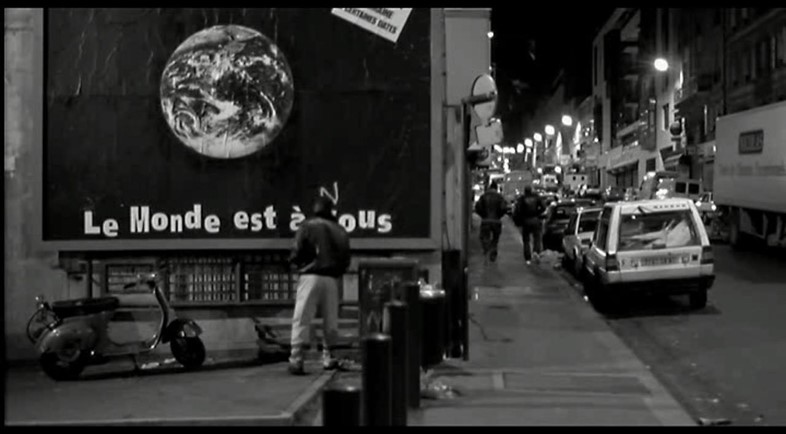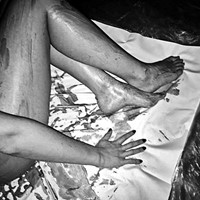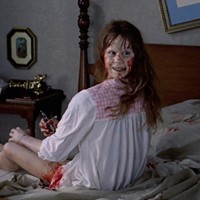The film exploring suburban youth still echoes the plight of outsiders while inspiring a new generation
As the dust begins to settle on the French Riviera, film buffs are fighting over whether first-time director László Nemes was robbed of the Palme d’Or for his highly praised Holocaust drama, Son of Saul. But one thing’s for sure: this year’s fest failed to deliver a scandal on a par with the furore surrounding Vincent Gallo’s The Brown Bunny (2003), Lars von Trier’s Hitlergate moment in 2011, or French cops turning their backs to Mathieu Kassovitz when he won best director prize in 1995 for La Haine, his searing indictment of French society’s exclusion of disenfranchised youths from the Paris projects (or cités).
As Kassovitz’s visceral debut celebrates its 20th anniversary, what’s most striking about this 24-hour window into the lives of three ethnically diverse male protagonists – Vinz (Vincent Cassel), Saïd (Saïd Taghmaoui) and Hubert (Hubert Koundé) – is that the shockingly gritty fable has lost none of its potency. Watching the opening credits, as Bob Marley’s “Burnin’ and Lootin”’ plays out over documentary footage of Paris riots, viewers will draw parallels with the violent clashes which beset the French capital’s banlieues in 2005, 2009 and 2013. Clearly, this “malaise of the ghetto” (as a posh gallery owner in La Haine sniffily puts it) remains as explosive as ever.
IT TORE THE RÉPUBLIQUE APART AND REBUFFED PARIS' STUFFY IMAGE
Kassovitz wasn’t the first filmmaker to chip away at Paris’ romanticised City of Lights veneer, but he proved the most effective at translating the anger of suburban youths subjected to institutionalised racism and police brutality. Riled by the April 1993 murder of a 17-year-old from Zaïre while handcuffed and in police custody, Kassovitz sought to expose the racial and class divisions that were tearing French society apart. In La Haine, Cassel’s character delivers a spot-on diagnosis of what’s ailing his nation: “It’s about a society on its way down, and as it falls, it keeps telling itself, ‘So far so good, so far so good, so far so good.’”
Besides shining a spotlight on the tensions between shady cops and brazen youths – and introducing one of the most bat-shit-cray, scantily clad cokehead characters in cinematic history (Astérix, or “Snoopy” for English subtitle readers) – the film proved enormously successful in exporting French culture abroad. Or at least, a strand of French culture obsessed with American culture: from the conspicuous streetwear and constant references to Scorsese to the arresting rap soundtrack, many of the film’s cultural touchstones originated across the Atlantic. One of the film’s most iconic scenes, which propelled Vincent Cassel into the big leagues, finds his character goofing off to Taxi Driver’s classic “You talkin’ to me?” moment in front of his bathroom mirror.

IT GAVE FRENCH HIP HOP A SPOTLIGHT ON THE WORLD STAGE
On the music front, La Haine was instrumental in bringing greater exposure to French hip hop, to the point where the film is pretty much required viewing for anyone interested in brushing up on the genre’s history. While Spike Lee’s claim that La Haine “is a complete rip-off of Do the Right Thing” is too silly to corroborate, there are nevertheless interesting parallels between Parisian DJ Cut Killer, who appears in one of the film’s slickest sequences, mixing KRS-One’s “Sound of da Police” with Edith Piaf from a concrete high-rise, and Bed-Stuy DJ Señor Love Daddy (Samuel L Jackson), as they both provide outlets for self-expression to their embattled underdog communities.
While French hip hop had obtained modest success prior to La Haine, the film shattered glass ceilings for the genre, heralding the full-throttle acclaim of rap hailing from the projects – some socially conscious and politically minded, others throwing light on the gangster grind. The film itself used music sparingly, but the companion CD La Haine – Music Inspired by the Film offered a wide-ranging snapshot of French hip hop comprising original material from the scene’s leading talents. Among them, Marseille rap pillars IAM, whose rhymes address pan-Africanism, Islam and politics; the radical riot-rap of Ministère AMER; an early-career appearance by acid jazz-tinged trio Les Sages Poètes de la Rue; and hardcore funk-rap act Expression Direkt. Alongside artists such as NTM and MC Solaar, this disparate crew proved to curious listeners that an NYC-led musical movement could be reclaimed on another continent to become a leading voice of outsider struggle.
ITS THEMES CONTINUE TO ECHO IN CINEMA TODAY
Twenty years on, La Haine’s tale of struggle in the banlieues continues to resonate with filmmakers and musicians of all stripes, with May Allah Bless France! and Girlhood offering new twists on a similar theme. The former, a blistering autobiographical rendering of rapper and spoken-word artist Abd al Malik’s hard-knock upbringing in Strasbourg’s Neuhof projects, tackles rap, delinquency and Islam through the monochromatic lens of La Haine cinematographer Pierre Aïm and a cast mostly comprised of non-professionals. Al Malik doesn’t play coy about his chief cinematic influence. “In my mind, (La Haine) was the first movie where a filmmaker actually wanted to show a tough neighbourhood from both a loving perspective and an artistic approach,” he explains. “Discovering this film as a kid was a powerful, indeed practically founding experience for me. Afterwards, when I met Kassovitz, we became friends and had a number of important discussions. He’s the one who encouraged me to become a director.”
For its part, Céline Sciamma’s Girlhood offers a refreshing counterpoint to all the XY swagger. The story of a shy teenage girl (Karidja Touré) from the outskirts of Paris who comes into her own upon joining a girl gang, the film explores how cash-strapped youths try to overcome the violence, isolation and hardships endured in their neighbourhood’s oppressive apartment blocks. But in this case, it’s done with greater intimacy and vulnerability, with an exhilarating karaoke rendition of Rihanna’s “Diamonds” and a hypnotic electronic score by Para One, formerly a producer of now-defunct French rap group TTC. When Konbini recently asked him about the legacy of La Haine, Para One also had very complimentary things to say. “It was my generation’s film, like Kids by Larry Clark. We had the impression that it was our lives, it was the music we listened to, the way we dressed... In Kids, it was the Aids generation, and in La Haine, it was the banlieue generation.”
So what to make of Kassovitz’s surprise announcement, in the wake of the Charlie Hebdo attacks, that he would work on a sequel? Sure, the director hasn’t found much success with projects post-La Haine, the racial tensions and anti-Arab sentiment across the country are as complex as they’ve ever been, and French hip hop is no longer exclusively the domain of the underground resistance. But if successive riots and unrest have taught us anything, it’s perhaps that the ailments of the banlieues two decades ago haven’t been remedied, which would give Kassovitz another shot at rattling the cage of social injustice.
In La Haine, Saïd spray-paints over a billboard ad featuring an image of the planet, full of promise, with a caption that reads: “The world is ours.” Would many in Hollande’s Republic recognise such a collective utopia as being within reach? Or might it be another case of ‘so far so good, so far so good, so far so good’? We might be due for a Kassovitz refresher.



